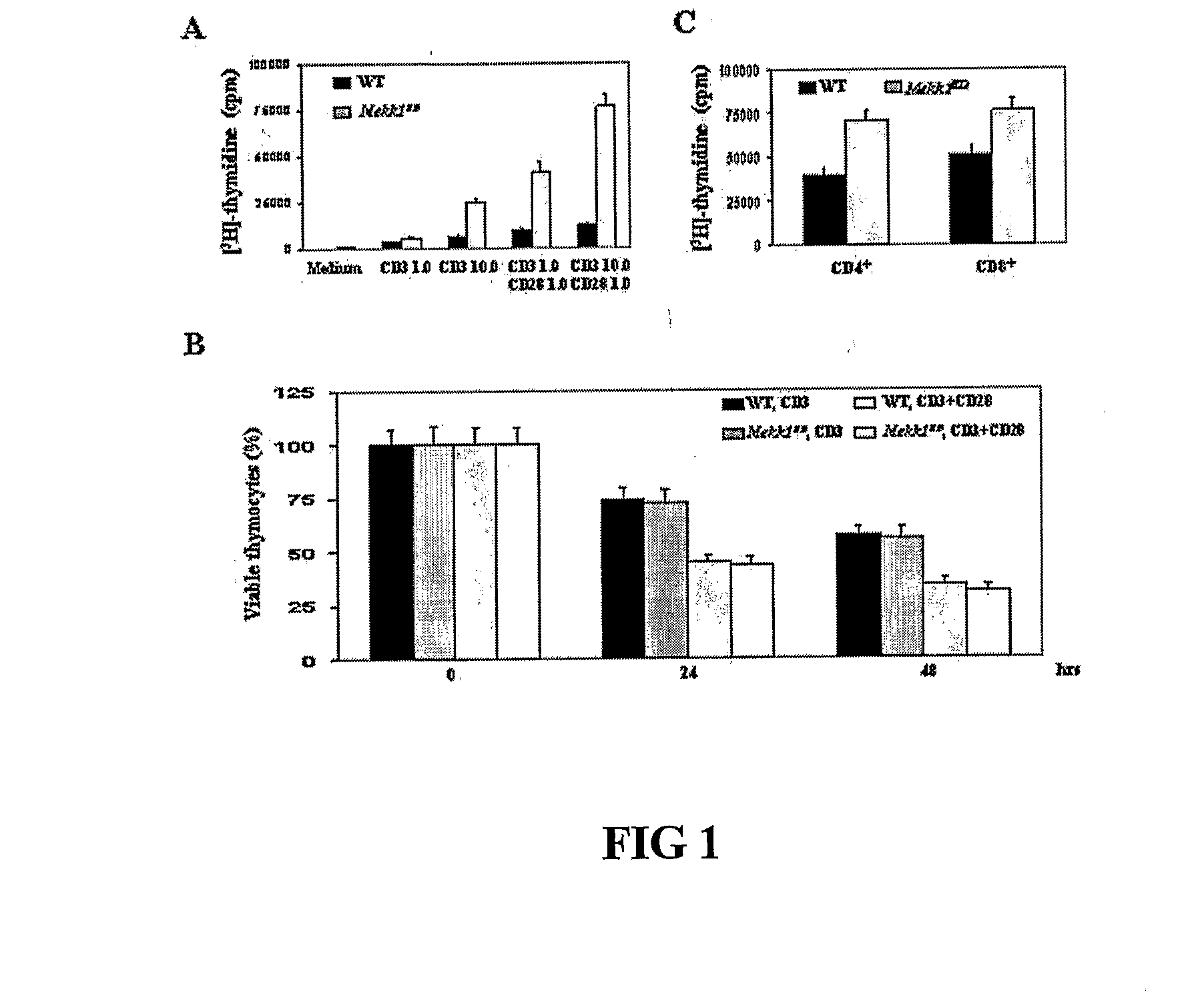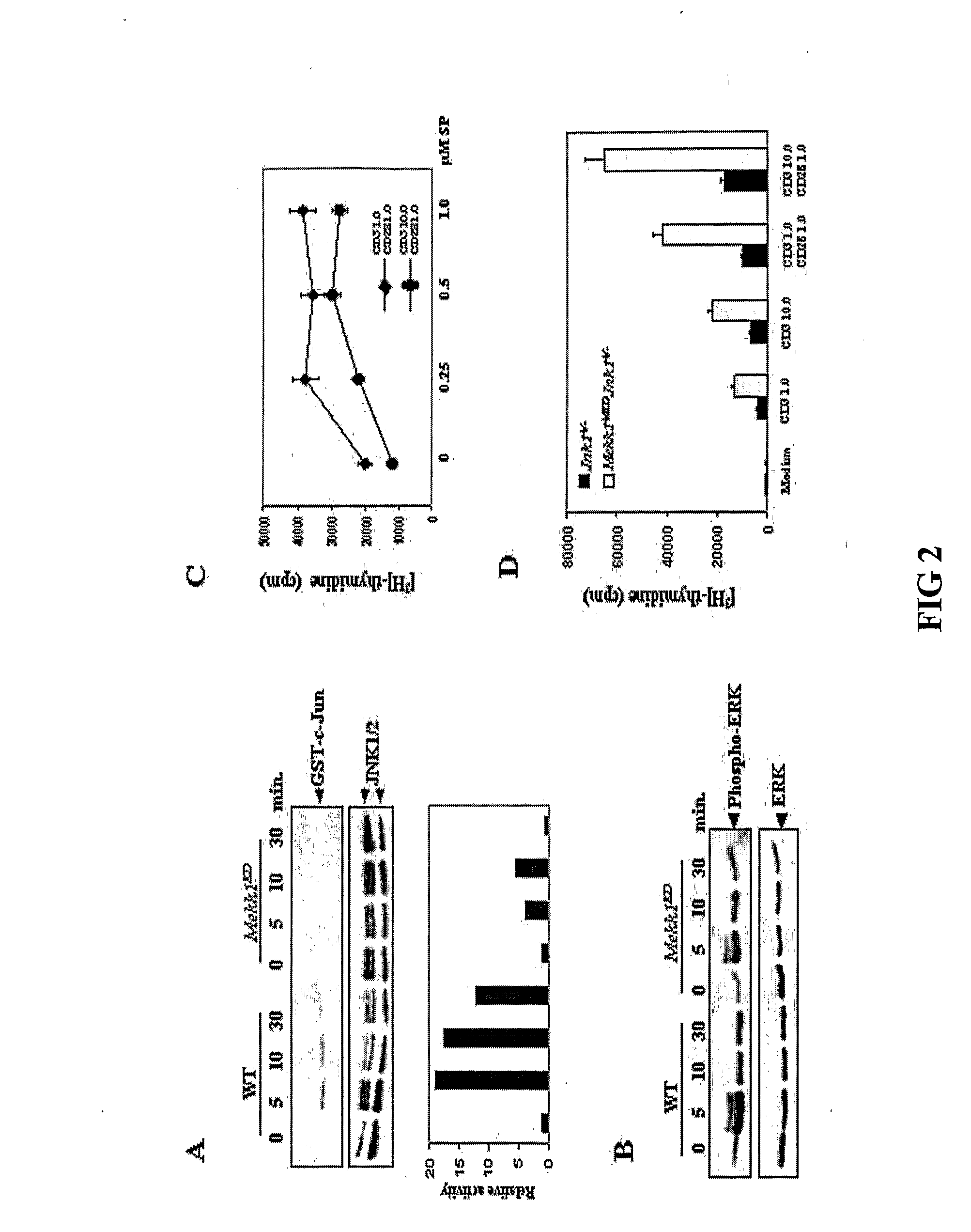Enhancement of Th2-Dependent and Inflammatory Response
a th2-dependent and inflammatory response technology, applied in the field of th2-dependent and inflammatory response enhancement, can solve the problems of high treatment cost and frequent injection or infusion, and achieve the effects of increasing the in vivo production of th2-cells, and reducing inflammation and diseas
- Summary
- Abstract
- Description
- Claims
- Application Information
AI Technical Summary
Benefits of technology
Problems solved by technology
Method used
Image
Examples
example 1
[0178]Materials and Methods The following is a description of exemplary materials and methods that were used in subsequent Examples.
Sources of Mice:
[0179]It is not intended to limit the source of mice. In one embodiment, mice were obtained by personal donations (for example, L. Chang for provided Jnk1− / − mice and E. D. Gallagher provided anti-MEKK1 antibodies). In one embodiment, mice were obtained by engineering and breeding mice (for example, Mekk1KD / KD mutant mice were generated by standard procedures from Mekk1KD ES cells, in which the MEKK1 kinase domain was replaced with a β-galactosidase coding cassette (Xia et al., 2000). Chimeric mice were generated by injection of Mekk1KD ES cells into C57BL / 6 blastocysts. As used herein, the term blastocysts and blastocyst cells refers to a preimplantation embryo of 30-150 cells. A blastocysts contains a layer of specialized cells made up of trophoblasts which function to attach to the uterine wall and form the placenta. Inside the tropho...
example 2
Hyperproliferation of Mekk1KD Mutant T Cells
[0193]Growth and differentiation tests were done to compare wildtype T cells to mutant T cells deficient in MEKK1 kinase.[0194]A. Thymocytes from WT and Mekk1KD mice were incubated with the indicated concentrations (μg / ml) of anti-CD3 or anti-CD3+anti-CD28 for 72 hrs. Cell proliferation was measured by [3H] thymidine incorporation. Results are averages of 6 experiments. (FIG. 1A)[0195]B. Thymocytes from WT and Mekk1KD mice were cultured with 5 μg / ml of anti-CD3 with or without 0.5 μg / ml of anti-CD28. At the indicated times, cell viability was determined by trypan blue staining. Values represent the mean proportion of viable thymocytes relative to untreated cultures (100%) in 3 separate experiments. (FIG. 1B)[0196]C. CD4+ and CD8+ splenic T cells from WT and Mekk1KD mice were treated with 10 μg / ml anti-CD3 and 1 μg / ml anti-CD28 for 48 hrs. Cell proliferation was measured as above. Results are averages of 3 experiments. (FIG. 1C)
[0197]While ...
example 3
Reduced JNK Activity Results in Increased Thymocyte Proliferation
[0198]The effect of the Mekk1KD mutation on activation of JNK and other MAPKs in response to TCR and CD28 engagement was investigated.[0199]A. WT and Mekk1KD thymocytes were incubated with anti-CD3 (10 μg / ml) and anti-CD28 (1 μg / ml). At the indicated times, JNK activity was measured by an immunecomplex kinase assay using GST-c-Jun(1-79) as the substrate. Phosphorylated c-Jun was detected by autoradiography and quantitated using a PhosphorImager. The level of immunoprecipitated JNKs was determined by immunoblotting. This experiment was repeated several times with similar results. (FIG. 2A)[0200]B. WT and Mekk1KD thymocytes were stimulated as above. At the indicated times, ERK activation was examined by immunoblotting with an antibody against phosphorylated ERK. The same membrane was reprobed with a general anti-ERK antibody. (FIG. 2B)[0201]C. Thymocytes were incubated with indicated concentrations (μg / ml) of anti-CD3 an...
PUM
| Property | Measurement | Unit |
|---|---|---|
| volume | aaaaa | aaaaa |
| catalytic activity | aaaaa | aaaaa |
| stability | aaaaa | aaaaa |
Abstract
Description
Claims
Application Information
 Login to View More
Login to View More - R&D
- Intellectual Property
- Life Sciences
- Materials
- Tech Scout
- Unparalleled Data Quality
- Higher Quality Content
- 60% Fewer Hallucinations
Browse by: Latest US Patents, China's latest patents, Technical Efficacy Thesaurus, Application Domain, Technology Topic, Popular Technical Reports.
© 2025 PatSnap. All rights reserved.Legal|Privacy policy|Modern Slavery Act Transparency Statement|Sitemap|About US| Contact US: help@patsnap.com



